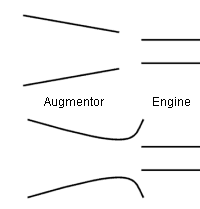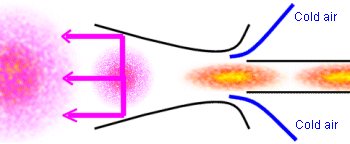Jet engine technologies for interested amateurs
Last Updated: 9 May, 2002
|
What is an Augmentor? A thrust augmentor is a separate device which is placed in the exhaust of a pulsejet engine to increase the amount of thrust produced. 
The addition of an augmentor won't affect the amount of fuel consumed so it also increases the effective fuel-efficiency at the same time. In their simplest form, a thrust augmentor is just a divergent (ie: bigger at the back than the front) cone into which the exhaust gases are fired. However, more efficient units use two cones or have an airfoil shaped contour. A thrust augmentor does for the pulsejet what an afterburner does for a turbojet.
How Do Augmentors Work? A. Pulsejets are not particularly efficient when used in static or slow-moving applications. This is because they create a very narrow column of fast-moving gas which is something akin to top gear in a car. Even the most powerful car will have trouble accelerating away from a standstill if it's stuck in top gear. The engine may still be putting out plenty of power but there's not much "torque" (or turning force) at the rear wheels. If we want our car to accelerate smartly then we need to use a lower gear to increase the torque at the rear wheels, albeit at the expense of top-speed (cars go faster in high gears than lower ones). This is the effect that an augmentor produces -- it is analogous to shifting the pulsejet into a lower gear so that more "push" is created, albeit at the expense of top-speed. The mechanism by which the augmentor works is as follows: The hot air ejected from the pulsejet tailpipe is moving very quickly (over 500 mph in many cases) and a very wise man called Mr Bernoulli once figured out that the pressure exerted by a gas is dependent on the speed at which it flows. The faster the flow, the lower the pressure. That sounds silly doesn't it -- after all, the harder and faster you blow on the palm of your hand, the *more* pressure you feel -- right? This apparent anomaly is perhaps better explained by saying that the reduction of pressure occurs at right-angles to the direction of flow. This means that when you blow air through a pipe, the pressure against the pipe walls is actually reduced -- even though there's more apparent pressure at the pipe outlet.

In the case of our pulsejet, this "Bernoulli effect" creates a low-pressure area around the hot gases coming out the tailpipe and this low pressure draws cooler, denser air into the gas-flow. With a plain pulsejet engine this results in tremendous amounts of turbulence and large swirling vortices where the hot and cold air mix. As they mix, the cold air is heated by the exhaust and expands but, since it's not confined in any way, this expansion doesn't add to the thrust -- it expands in all directions so the reactive forces cancel out. However, when we add an augmentor we have a degree of control over the expansion process. The cone shape means that the heated air can no longer expand evenly in all directions and instead, the only direction it can expand is towards the rear of the cone. Mr Newton then steps up to the plate and states that "for every action there is an opposite and equal reaction" -- which basically means that because the heated air now is travelling only towards the rear of the cone, there is a reactive force exerted on the cone that tries to push it forward. We recognize this reactive force as "thrust." The force generated by the augmentor adds to that created by the engine itself and an augmented engine can, in some cases, effectively produce double the thrust when compared to an unaugmented one. Q. Isn't this a free lunch? A. Not quite. Due to its shape and the frontal area it presents, an augmentor creates drag once it (and the engine to which it's attached) starts moving through the air. As the speed continues to increase, a point will be reached where the drag produced by the augmentor will match, or exceed the extra thrust it provides. Just as with the car analogy, augmentors provide for more push at low speeds but are not much good at high speeds.
Designing and Building an Augmentor
|
|
